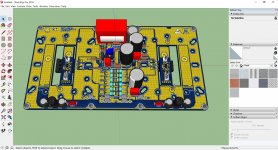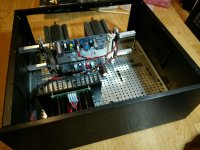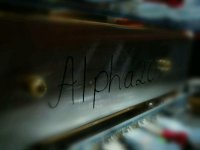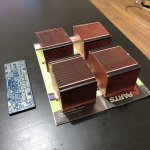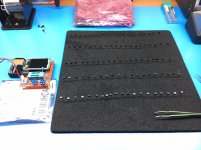Another step closer Pcgab 😀
Runnning the lower bias 1.3A, you should be fine with those heatsinks. Since I changed to that value, the ALPHA runs much cooler. Looking forward to hearing yours and Juntuins listening impressions.
Runnning the lower bias 1.3A, you should be fine with those heatsinks. Since I changed to that value, the ALPHA runs much cooler. Looking forward to hearing yours and Juntuins listening impressions.
What is that little PCB on top of the output devices. If it is for controlling fan speed I am not sure why. When you set the SE bias, it will dissipate power from the onset, until you switch it off. It is not a class AB amp for parties that gets hot and cools down as the power increases and decreases.
However, if your argument is that it compensates for ambient changes then you only need one control that looks at ambient and can be on the main PCB no need to monitor a transistor. Sorry for chipping in but I have been following this thread from the outset with interest since I enjoy reading Hugh's comments.
However, if your argument is that it compensates for ambient changes then you only need one control that looks at ambient and can be on the main PCB no need to monitor a transistor. Sorry for chipping in but I have been following this thread from the outset with interest since I enjoy reading Hugh's comments.
That fan controller part is a “breakaway” part and is placed there for purposes of cost effective PCB fab as it is made as part of main board. It will actually mount on a small mezzanine riser (you can see the PCB socket for riser and stand-off pad nearby). The fan controller PCB is PWM and we want to keep the digital pulses away from main PCB to the extent possible. There will be a NTC thermistor connected to fan control board that will then touch some part of heatsink for temperature sensing. That uses the 2pin PCB connector on the fan controller board.
The power to the fan controller board goes through a CLC filter on the main board. Hopefully his will helps isolate the fan controller from main amp from noise. I admit that this is risky and may not work. In which case we mount the fan controller away somewhere in the amp case and give it its own 12v power supply to really isolate the fan PWM noise. This is a TBD and we will see what happens when I build prototype zero and beta test it. The mitigation for the noise is almost 100% if we move controller far away and on separate PSU. So I am not too worried.
The power to the fan controller board goes through a CLC filter on the main board. Hopefully his will helps isolate the fan controller from main amp from noise. I admit that this is risky and may not work. In which case we mount the fan controller away somewhere in the amp case and give it its own 12v power supply to really isolate the fan PWM noise. This is a TBD and we will see what happens when I build prototype zero and beta test it. The mitigation for the noise is almost 100% if we move controller far away and on separate PSU. So I am not too worried.
Looks like from quad processor 1U Xeon server. Possibly SuperMicro case? Definitely needs a fan. Might work ok with slower fan but I know those servers are noisy. They sound like a jet airplane on a runway.
Nice find though. Copper is almost impossible for amateurs to drill and tap so be careful.
Nice find though. Copper is almost impossible for amateurs to drill and tap so be careful.
Looks like from quad processor 1U Xeon server. Possibly SuperMicro case? Definitely needs a fan. Might work ok with slower fan but I know those servers are noisy. They sound like a jet airplane on a runway.
Tracked it down to a HP server for socket 604 Xeon:
HP Xeon 604 Copper Heatsink - Socket-604 Xeon Cooler
Can we see FFT from Combo ?
Hi,
Congratulations to you and Dean for these results.
In the last year I was watching and studying preamp and power amplifiers with dominant 2nd and 3rd harmonics ( SS and Tubes ) because their sonic reputations. Now, seeing your Lender and Alpha with last modifications quoted above, it makes me wonder to see the FFT combination ( first watt, 5w, 10w..etc ) .
Is it possible ?
I did an experiment last night and reduced R113 to 15k for a 23.5dB gain amp. This in combination with the Aksa Lender Preamp running with 6k8 feedback resistors in combination produced an unbelievably good sound. I was listening to a 1956-1957 recording of Ella Fitzgerald and Louis Armstrong, a CD I have had for many years, but now it is like WOW, the vocals clarity, dynamics, depth of realism, it was like they were there in my lab - singing live. The nuances and emotions of “Summertime” was something was not quite prepared to experience. Just wonderful - I almost slipped into staying up all night just to listen over my music collection but had some self control and stopped at 330AM 🙂 Work today still has to get done despite my wishes to just enjoy my music.
This works because I am driving with a good preamp. If you don’t have a preamp, you should probably keep it at usual 27dB gain with R113 set at 22k.
I have asked Vunce to try same configuration to see if he experiences similar increase in SQ. So with experience we are seeing some fine points of the setup that might be customized depending on your application.
Hi,
Congratulations to you and Dean for these results.
In the last year I was watching and studying preamp and power amplifiers with dominant 2nd and 3rd harmonics ( SS and Tubes ) because their sonic reputations. Now, seeing your Lender and Alpha with last modifications quoted above, it makes me wonder to see the FFT combination ( first watt, 5w, 10w..etc ) .
Is it possible ?
Beautiful sinks Aatto!
Thanks 😀 yeah old school server heat sinks for xeon cpus.Aatto,
Those are nice - looks like CPU heat-sinks from servers?
technically it should be able to support xeon 7150N with 150w TDP, of course accompanied by noisy server fans.
Nice find though. Copper is almost impossible for amateurs to drill and tap so be careful.
yeah, i hate it, i did some copper cnc milling in the past and it is not fun, if it didn't work out i will use thermal adhesive as last resort.
it certainly does, our blade server has 10 exhaust fans, each one rated at 16A ! (12v)but I know those servers are noisy. They sound like a jet airplane on a runway.
Tracked it down to a HP server for socket 604 Xeon:
that was fast !
Last edited:
Hi, what are the thoughts about having rail fuses after the power supply. Nothing has been mentioned up till now, I normally use them but am open to all opinions.
Regards
Alan
Regards
Alan
A fuse on the mains AC leading to the primary of the transformer is enough. Although it doesn’t hurt to have more fuses locally.
Hi Hugh,
Can you confirm that these are the optimal outputs to get for the B.B.?
P-channel:
IXTK90P20P IXYS | Mouser
N-channel:
IXTK88N30P IXYS | Mouser
IXYS has to do something about their tongue-twister part numbers. Can’t memorize or even say it. $15ea for the P channel - ouch. But I guess it precludes needing to do matching.
Can you confirm that these are the optimal outputs to get for the B.B.?
P-channel:
IXTK90P20P IXYS | Mouser
N-channel:
IXTK88N30P IXYS | Mouser
IXYS has to do something about their tongue-twister part numbers. Can’t memorize or even say it. $15ea for the P channel - ouch. But I guess it precludes needing to do matching.
IXYS has to do something about their tongue-twister part numbers. Can’t memorize or even say it.
😀
I’ll buy 100 then and offer hFE matched sets for free to any ALPHA builder.
BK
Measured 100 devices for hFE with my hot-rodded tester. Will have a good batch of matches.
BK
Attachments
Downstream fuses are often placed so that separate components have their own fuses sized to ensure appropriate de-energisation upon failure for those sections.Hi, what are the thoughts about having rail fuses after the power supply. Nothing has been mentioned up till now, I normally use them but am open to all opinions.
Regards
Alan
For example, if you had a pre-amp board and main amp supplied from a common power supply, so the main power supply was fused for the full power of the main amplifier but without secondary fuses, a short circuit failure on the pre-amp may result in a potentially dangerous situation when the small components and wiring may not necessarily cause the main fuse to blow but is able to sustain a heat up, disintegrate, or arc over/eject hot material. Depending on the specific circumstances this sort of scenario could lead into a device fire.
The same risks become a consideration when you get to larger multi-channel configurations.
Thanks for the replies. Mt490, yes I am aware of the scenario you mention, perhaps I didn't phrase my question correctly. Over the years there has been discussions about if placing fuses in the supply rails is detrimental to audio quality. I wondered if anyone could give a definitive answere. If it was just down to safety I would use rail fuses, but I know of designs that don't.
As X mentioned a closely rated fuse on the transformer primary may be all that is required, but As I am using a 250VA transformer for each Chanel I was not going to use an inrush limiter, so hence the primary fuse may be rated too high. Perhaps I should consider an inrush limiter?
Regards
Alan
As X mentioned a closely rated fuse on the transformer primary may be all that is required, but As I am using a 250VA transformer for each Chanel I was not going to use an inrush limiter, so hence the primary fuse may be rated too high. Perhaps I should consider an inrush limiter?
Regards
Alan
- Home
- Amplifiers
- Solid State
- Aksa Lender P-MOS Hybrid Aleph (ALPHA) Amplifier
